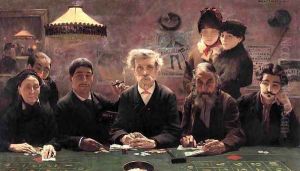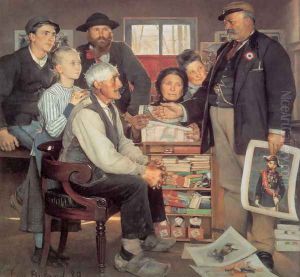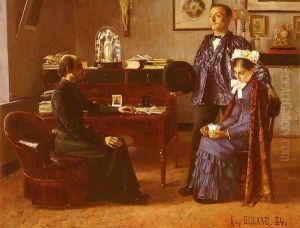Jean-Eugene Buland Paintings
Jean-Eugène Buland was a notable French painter associated with the Naturalism and Realism movements, born on October 26, 1852, in Paris. His work is characterized by a meticulous attention to detail and a focus on social realism, often depicting the lives of the working class and the rural poor with a sense of dignity and gravitas.
Buland demonstrated artistic talent from a young age and pursued formal training at the École des Beaux-Arts in Paris. He studied under Alexandre Cabanel and Henri Lehmann, two prominent academic painters of the time. Buland's early works were influenced by the academic style, but as his career progressed, he began to develop a more distinctive approach that emphasized the everyday experiences of ordinary people.
In 1879, Buland won the prestigious Prix de Rome for his painting 'L'Assaut de la redoute' ('The Assault on the Redoubt'), which allowed him to study in Rome at the Villa Medici. The experience in Italy had a significant impact on his art, and upon his return to France, he began to exhibit his works at the Paris Salon, where he received considerable acclaim.
Buland's paintings are known for their use of clear light, precise composition, and the often somber expressions of his subjects, which convey a sense of the weight of their daily struggles. Notable works include 'Le mariage innocent' ('The Innocent Marriage'), 'La Charité' ('Charity'), and 'L'Arroseur' ('The Waterer'), all of which demonstrate his commitment to depicting the realities of life without idealization.
In addition to his social realist works, Buland also created a number of portraits and allegorical paintings. He was awarded medals at various international exhibitions and continued to receive commissions and recognition throughout his career.
Jean-Eugène Buland's legacy is that of an artist who captured the spirit of his time by reflecting the social issues and the dignity of the common man. His works remain important in the study of 19th-century French painting, particularly within the context of the Naturalist movement. Buland passed away on March 3, 1926, leaving behind a body of work that continues to resonate for its technical skill and its compassionate portrayal of humanity.


![Le Tripot [detail] (The Gambling Den) I](https://www.niceartgallery.com/imgs/117625/s/jeaneugene-buland-le-tripot-detail-the-gambling-den-i-c573a004.jpg)


![Le Tripot [detail] (The Gambling Den)](https://www.niceartgallery.com/imgs/117628/s/jeaneugene-buland-le-tripot-detail-the-gambling-den-f258303b.jpg)